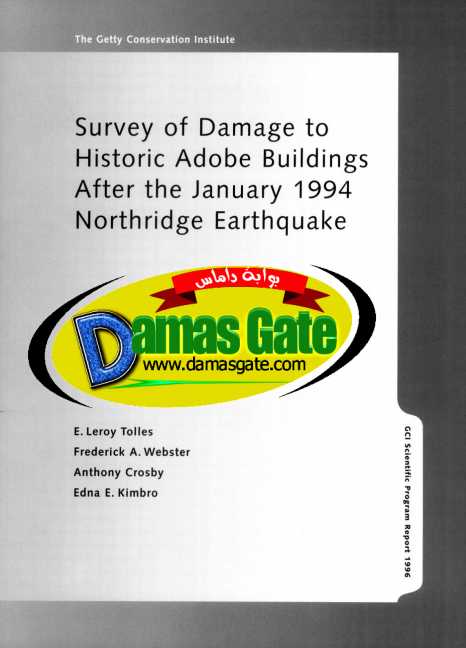Survey of Damage to Historic Adobe Buildings after the January 1994 Northridge Earthquake
Preface
California’s periodic and often destructive earthquakes are grim reminders that many historic and culturally significant buildings pose substantial risks to the life and safety of their occupants. In addition, the loss or damage to our Early American, Spanish colonial heritage in the form of irreplaceable historical fabric, architectural details, objects, and **********s increases with each new earthquake. In particular, California’s historic adobe structures, which include missions and secular buildings, have been subjected to devastating earthquakes. Even after rebuilding or repair, a number of these structures have retained much of their authenticity and still carry the scars that demonstrate their toughness and survivability.

Although a good deal is now known about the behavior of some unreinforced masonry buildings during earthquakes, very little was known until recently about the factors that determine how adobe buildings respond to seismic forces. In 1990, the Getty Conservation Institute undertook a research project to study methods for retrofitting historic adobe structures
-minimally intrusive methods that would be consistent with maintaining the architectural, historic, and cultural values of the buildings. Since that time, the Getty Seismic Adobe Project (GSAP) has carried out earthquake simulation tests on model adobe buildings, both retrofitted and unmodified. In the process, it has accumulated a wealth of information on how adobe buildings respond to simulated earthquakes and how retrofitting can prevent the occurrence of catastrophic damage.
As in all research that involves simulation of the effects of natural processes on
modeled test specimens, some element of doubt exists concerning the extrapolation of laboratory results to the real world. The occurrence of the Northridge Earthquake of January 1994, which measured 6.4 on the Richter scale, provided an unusual opportunity to study, at first hand, the effects of severe shaking on historic adobe buildings. As an
extension of GSAP, project personnel, including seismic engineers, an historical architect, and a conservator/historian, surveyed nineteen adobe buildings in the affected area to determine the extent and type of earthquake-related damage. During the survey, observations were made on conditions existing prior to the earthquake, the presence of
previous retrofitting, and actual structural details of the building
-all factors that bear on the response of the building to seismic stress. This information, together with an analysis of the earthquake characteristics at each site and GSAP findings on failure modes from model studies, are correlated in this report and provide the basis for comparison between simulated and real effects and how effective retrofitting of historic adobe structures can be used to preserve what remains of our adobe architectural heritage.
Download
*